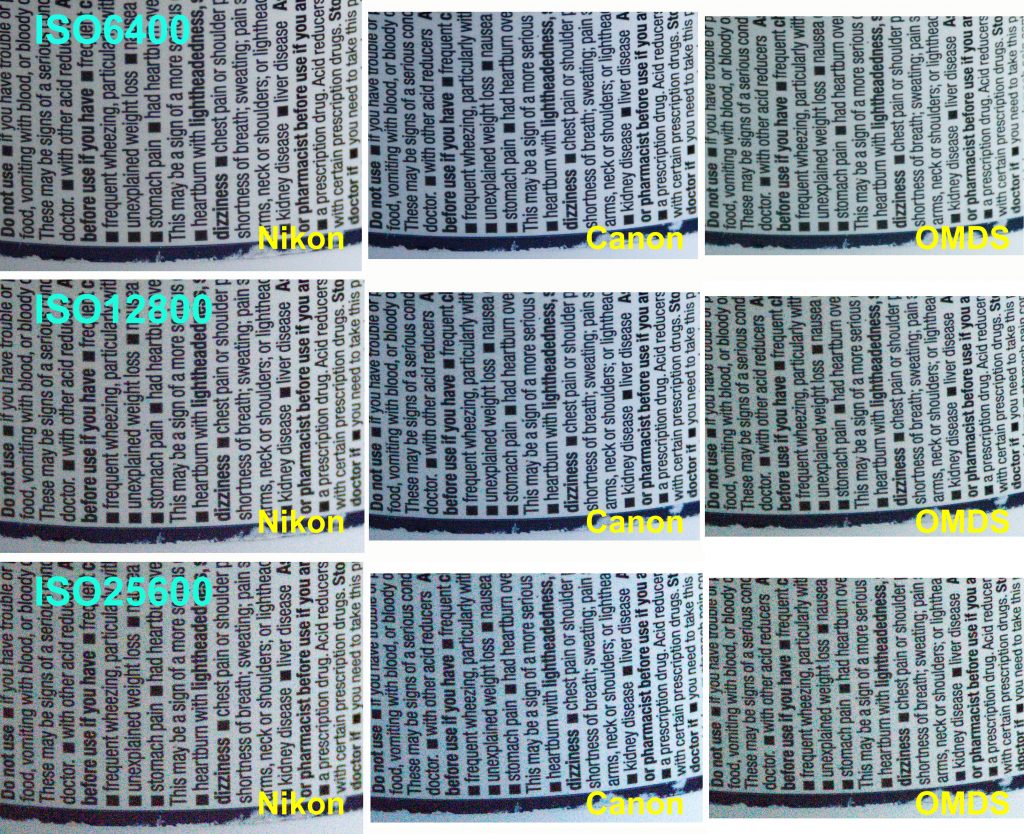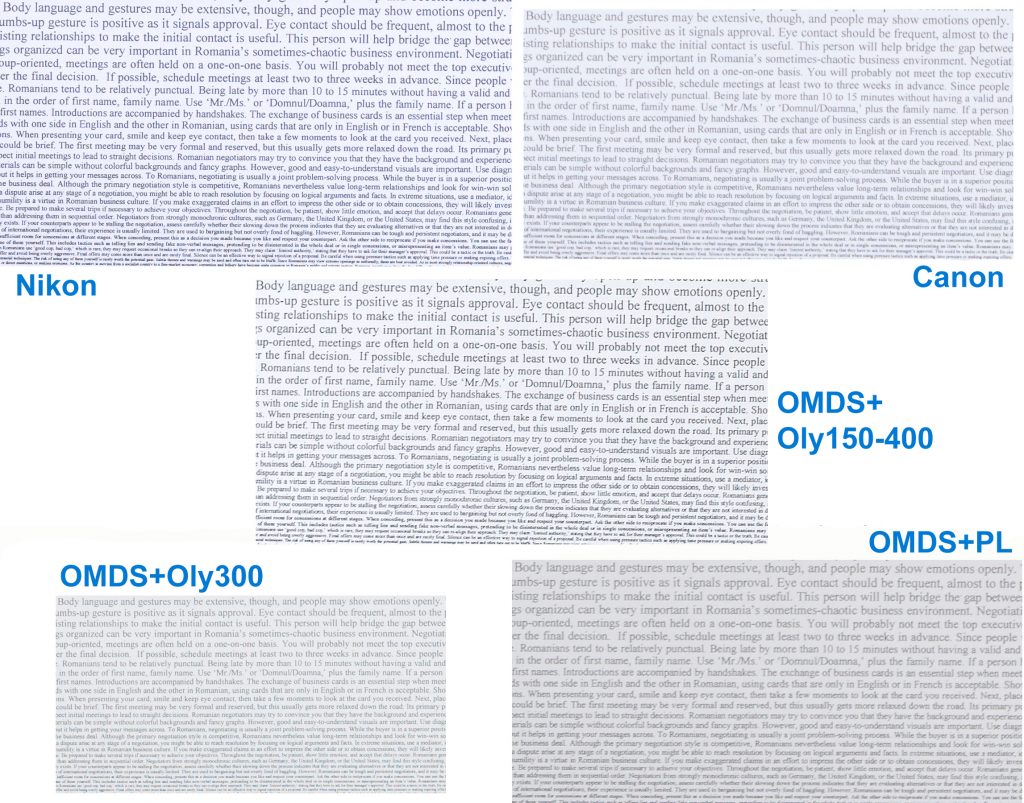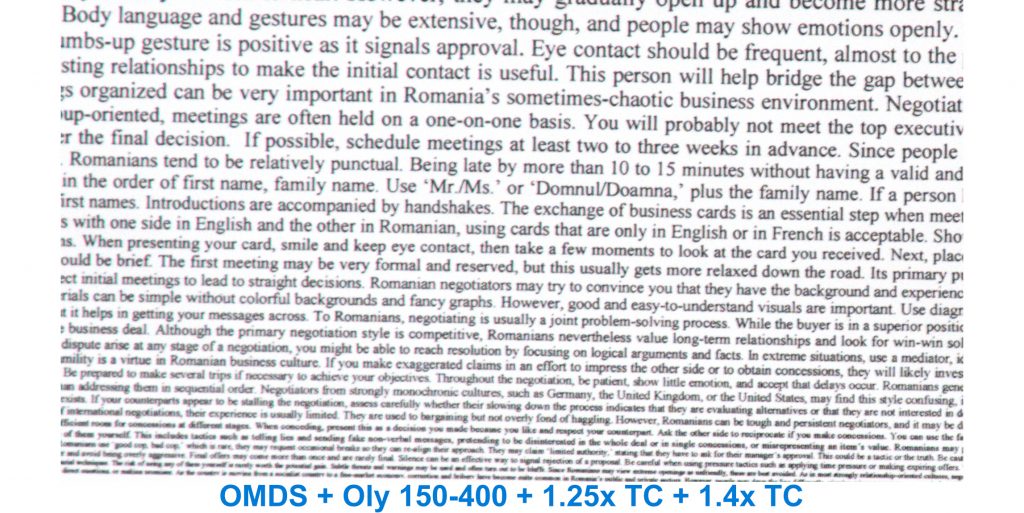Back to Part II: Lenses, AF impressions
Five body/lens combinations for mobile bird shooters: Part III
Test shots:
As already discussed in Part II, I will not compare keeper rates, as doing so could be misleading. I feel competent enough, however, to compare AF systems, assess each body’s tracking competence, and get test shots that allow comparing the IQ with each body/lens combination. I’ve also owned enough long primes and zooms (300, 500, 100-400, 100-500, 200-500, …) to know how to handle one properly. Shots I am sharing here are always “best of several” in order to minimize tester errors. All shots were taken wide open, as I am much more interested in how these lenses perform in typical small-bird situations (the bird is in the shade and the light is dim). Keep in mind that unlike older designs, most modern lenses are nearly as sharp wide open as they are stopped down. From my experience, I would expect a notable improvement in sharpness with the PL lens, but not with the other three – which leads to an oxymoron, since the PL is the one that needs as much light as it can get. In other words, you’re rarely going to use it at anything other than its maximum aperture anyway.
Images are always shown in the same order, from left to right: Nikon Z7ii + 500mm PF, Canon R5 + RF 100-500mm, OM-1 + Olympus 150-400mm, OM-1 + Olympus 300mm, OM-1 + PL 100-400mm. Unless otherwise mentioned, images were shot in RAW and converted in DxO Photolab with no corrections applied. The Nikon tends to have a neutral cast here, whereas the Canon is slightly blue-ish and the OM-1 green-ish, but I would not read too much into this. It may have to do with DxO’s conversion engine not applying automatic corrections.
I’ll start with three series of test shots that give us some clues from a bird shooting perspective. All of them use the same subject and distance, which was about 2.40-3m / 8-10ft. This is not realistic for actual bird shooting unless you shoot from a well-designed hide, so the relative sharpness comparison of these combos could look different if shooting from farther away. It is indicative, however, of light vs noise in each shooting situation. All images shared here are extreme center crops: the section of the pill box showing in each of these extreme center crops is about 1.8cm / .7“ high. These are 100% crops, so they also show the relative image size comparison with each combo.
The first series assumes that a bird sits perfectly still in low light, such that I can shoot at a slow shutter speed of 1/60s. In order to keep noise from getting excessive, I shot these images at ISO3200, so they test the image stabilization and demonstrate how each lens’ maximum aperture affects the images when all else is equal. None of these images were edited, other than converting them from RAW to JPG.

Something that often gets overlooked is noteworthy here: MFT lenses equal their stated aperture with regards to how much light they take in, while they equal 2x their stated aperture with regards to DoF and bokeh. In other words, the Oly 300 f/4, for example, performs like an f/8 lens as far as DoF and bokeh go, but in low light, it allows for a full two stops lower ISO levels (or higher shutter speeds) than a FF f/8 lens would. This gives the 300 f/4 a 1 2/3 stop advantage over the RF 100-500 at 500mm and f/7.1, more than required to compensate for the R5’s better low-light performance compared to the OM-1. In low light, the OM-1 + 300 f/4 combo has an edge over the Canon combo and also ups the ante for Nikon with its otherwise superb lens. A crucial aspect for me, as several of my best bird pics were taken in dim light. The OM-1 + PL, on the other hand, is rather dim but appears relatively sharper at the left and right side of the image, as its greater DoF keeps more of the print on the round pillbox in focus.
Note that there appears to be quite a bit of focus breathing: the Big White presents the largest image size, as it should, but its image is not larger than the Nikon one by as much as the math would have us expect, as discussed under ‘Lenses’ in Part II. The PL shot, supposed to yield a same-size image as the Big White, is a little smaller than the Nikon’s, which is in turn supposed to come in only a hair larger than the Canon’s but is significantly bigger. In other words, all three zooms show more focus breathing than the primes do, albeit to varying degrees, with the Big White showing the least of it.
Next, I assumed a perched bird in low light that does not sit perfectly still, so I upped the shutter speed to 1/250s. This time, I wanted to get similar looking images, so the variable I adjusted for each body and lens combination was ISO, ranging from 4000 for the Oly to 8000 for the PL.

The images shot with the OM-1 show higher noise, but there is nothing that could not be corrected in post. All of them would certainly benefit from some noise reduction. [Note: The shot with the Big White has a different color cast because it was shot on a different day and in different light. Not a relevant aspect here.]
These first two image series also give us a hint at near-distance lens sharpness, which may be relevant when shooting from a hide that allows close proximity to the birds. Looking at these 100% crops, the differences seem less pronounced to me than I expected. The Nikon and both Oly lenses all look quite sharp. The Canon looks about the same as the PL, which is surprising, but both of them deliver decent sharpness here.
The third series of shots now looks at noise at high ISOs. These give us an idea about how much we may be able to crank up the ISO with each body before the results become unusable. I included the Oly lenses in my tests but am not showing them here since the noise is identical to the PL images when all are used at the same ISO value. I always shot wide open, making shutter speed the variable parameter. It ranged from 1/250s, with the OM-1 + PL at ISO6400, to 1/2000s, with the Z7ii at ISO25600. I kept these shots slightly underexposed, as doing so brings out the noise more clearly.

These results were a surprise to me. At less than half the megapixel count of the other two while having a sensor that is only a little over one-quarter the size, the OM-1 has much smaller pixels. More noise is therefore inevitable with its smaller sensor. Yet, it fared much better than I would have expected. At all three ISOs, it shows slightly more luminance noise than the other bodies, but the differences are rather small. Especially at ISO25600, where I would have expected the OM-1 to be all but unusable, the noise in the image can still largely be removed with good noise reduction software (DxO DeepPRIME, ON1 NoNoise, Topaz DeNoise AI). I would not hesitate to take any of these combos up to at least ISO12800, and consider 25600 still workable, though a stretch.
Ok, with these aspects out of the way, let’s look at longer-range sharpness and contrast, or, in more technical terms, resolution, now evaluated in a setup that may be more meaningful for most bird photographers. This next series of shots was taken at a distance of about 12.5m/40ft (on tripod, manually focused, IBIS and lens IS turned off). The largest font size you see in these crops is 9.5 point, the smallest is 3.5 point (hint: that’s small). I had planned, and tried in several ways, to shoot each body at its base ISO, but had to give up after several attempts: even on my expensive-and-sturdy FLM tripod with my expensive-and-sturdy Flexshooter head, shooting at base yielded poorer results than shooting at higher ISOs with the resulting higher shutter speeds. This is because when shooting at focal lengths of 500mm+, even miniscule movements (there was a little bit of wind) already cause some loss of sharpness. Furthermore, when looking at the subject on the LCD screen with high magnification, even the impact of the shutter shock was clearly visible as an oscillation. Expectably, this was less pronounced with the heavier combos. It got more pronounced the longer the focal length was. In other words, not as much of an issue with Nikon and Canon, but quite notable with all OM-1 combinations, with the lightweight OM-1 + PL 100-400 combo being the worst. Shooting at ISO800 took care of it except for two combos: the PL 100-400 is too lightweight and still produced pronounced motion blur at ISO800, and even the Big White, in spite of its heft, still showed a little of it at its 800mm FF equivalent focal length. Rarely an issue for bird shooting as you would never shoot at shutter speeds of 1/30s or so, as I had to do here.
As always, all of these shots are “best of several”. These are again the resulting resolutions, as in “pixel area”, you get when shooting with each of these combos, so it presents an apples-to-apples comparison. The Nikon (ISO64, 1/20s) and Canon (ISO100, 1/15s) were shot at base ISO, the OM-1 versions at ISO800 and 1/250s (Oly 150-400), 1/320s (Oly 300) respectively 1/160s (PL). [Side note: the Oly 150-400’s and 300’s focus ring each has an extremely short throw, making accurate manual focus a gamble. This is easier with the Nikon and Canon, and much easier with the PL lens.]

As mentioned, the PL shot still shows plenty of motion blur. The Big White shows a little of it, too, visible when inspecting the smallest font sizes. An 800mm lens is a whole lot more difficult to keep completely still than a 500mm one.
Image sizes are still not quite what would be expected (the OM-1 with the PL lens was supposed to yield the largest image area but ended up exactly the same as the Nikon; Canon’ image area ended up smaller than expected). This points to these lenses’ focal lengths not being exactly as specified, but the differences are small enough to be a “don’t care” (for me).
The Nikon lens is exceptionally sharp and delivers high contrast: at 100%, I can still read 4-point text just fine. Keep in mind: that’s from a distance of 12.5m/40ft! Even the 3.5-point one, all but indecipherable in the other shots, is still legible with the Nikon with some effort. When discounting the motion blur impact I described above, the Big White stays within a hair of the Nikon. Look closely: if it weren’t for the motion blur, you could read even the smallest text just as well with the Big White as with the Nikon. Quite an accomplishment, given the bodies’ resolution difference of 45.7 versus 20.4 megapixels. Canon and Oly 300 look about at par to me, save for the Oly’s lower resolution. Both are good, but not as excellent as the previous two. After mentally adding some improvement to compensate for the motion blur, the PL lens doesn’t look too bad, either. It is clearly not in the same league as Canon and Oly 300 but still delivers decent enough resolution.
Just for the fun of it, I added a shot with the OM-1 and the Big White, now with its built-in 1.25x TC engaged and an external 1.4x TC added, to this comparison. This means that the focal length is now at a full-frame equivalent of 1,400mm! I expected the two stacked TCs to cause quite some loss in sharpness, but it wasn’t too bad: while we again see a bit of motion blur in the smallest font sizes, which here means a 3-point font (!), the resulting resolution is quite impressive for a 20MP body. The scale of this shot is the same as in the previous set, testimony to how much magnification these TCs add:

All lenses perform better in the center than they do in the corners. In order to get an idea of how much variance this introduces, I also compared center vs worst corner sharpness for each body/lens combination, always shot wide open:





No big surprises here: all lenses show some deterioration, the primes remain sharper in the corners than the zooms do, with the 500 PF confirming what an exceptional lens it is, and the 100-500 is sharper than the 100-400 at the tele end. None of them are terrible and, to be perfectly honest, this is another “don’t care” for me, as soft corners are usually not a concern when shooting birds.
Lastly, since we are looking at ML bodies here, rolling shutter must be expected when shooting with electronic curtain. In order to visualize it and allow a comparison, I shot my DJI Mini 2 drone in flight, at 1/8000s and with each lens wide open. Since I was shooting indoors, this resulted in very high ISOs, so the images were corrected for noise. The results are entertaining. 🙂
The Nikon apparently needs several rotations of the blade before it read out the full image. There must be some kind of delays in-between, so the resulting image suddenly gives the drone several ‘virtual blades’. The Canon shows some amount of rolling shutter, as these blades are supposed to be straight but appear bent, but it’s not too bad. Since birds usually move slower than the drone blades do, this will rarely affect real-world images. I’ve shot tons of birds with the Canon and never saw hints of rolling shutter that I could make out. Lastly, the OM-1, with the Oly 300mm, shows almost no rolling shutter: the blades are straight. After all, it has the highest frame rate of the three bodies, which translates to the fastest sensor readout. To be honest, it beats me why the blades are rather unsharp in the latter shot, which occurred in all shots of the drone I took with this lens. Some loss of sharpness is expected, but on the OM-1, the blades consistently seemed less sharp than on the R5, though both combos had the antennas in focus and sharp. Go figure.
